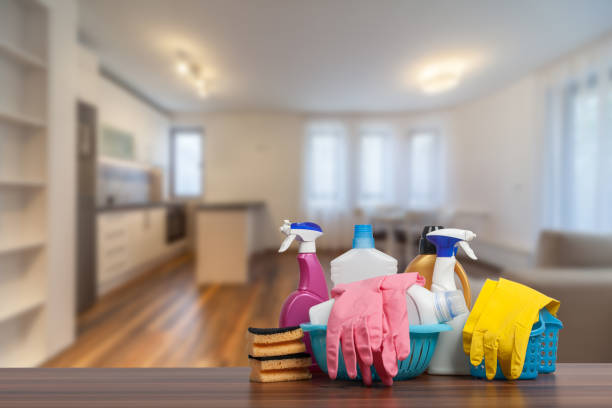Table of Contents
From sleek marble to rustic stones, bathroom basins come in many different types. Remember that washbasin is the most commonly used feature where you use a brush, clean your face and hands throughout the day. Such activities put a toll on the overall look and condition of the basin. The build-up of limescale and soap leftovers can affect the quality of your basin – and if these accumulations are left for too long, it would become a huge task to remove them completely.
Therefore, you should take proper care of your basins. You should clean your basin at least once a month with gentle cleaners. Each bathroom basin type will have different characteristics based on its type. So you need to know what kind of stone your sink is made of.
The Type Of Stone
Stone sinks are available in different types – hence, they are also likely to have different features. Frankly speaking, if you do a thorough search on the internet, you will find that there are almost 40 types of marble and granite available. Granite material can range from hard and tight-grained to soft and porous. Another stone type that falls under the soft category is the soapstone.
Among the most popular options, you’ll commonly find marble basins, river stone basins, and wood stone basins. Each of these brings its own unique look and set of care requirements to your bathroom. Marble basins offer timeless elegance but tend to be more porous and may stain if not sealed and cleaned properly. River stone basins stand out with their rustic, natural appeal and are generally more durable, though they can still develop soap scum or mineral buildup over time. Wood stone basins, though less common, combine organic textures with stone’s resilience, adding a distinctive character to your space.
Understanding the specific stone type your basin is made from will help you choose the best cleaning approach and avoid using products that might harm the finish or texture.
Daily Maintenance
One of the major problems is the accumulation of mineral deposits. Continuous use of water without removing the limescale and cause hard stains on the basin which might be difficult to remove. The quality of water also affects the basin. For example, people living in areas having hard water are likely to face such problems. Do not pour any coloured liquid like fruit juice or coloured detergents or hair dyes. To keep your bathroom basins in good condition avoid using any kind of products containing sodium. Sodiumruins your stone sink.

Cleaning
For cleaning your stone sink, try to avoid any kind of acid-based or abrasive cleaners. These harsh chemicals can stain the skin. You’ll find plenty of cleaners in the market that are particularly sold for cleaning stone sinks. Avoid using cleaners with citrus oil content – the fruit acids will damage the quality. For most stones, mild dish wash works perfectly. However, if the bathroom basins are of granite, you’ll have to look for special cleaners. Try to avoid cleaners having added pumice. You can use them only if it is written on the manufacturer’s instructions. Get professional help from your supplier or carefully read the manual instruction.
Protecting
Based on the type of stones, the sealing will be different. The type of the sealer will depend on the type of sink you have. This is a thumb rule that stone sinks with open grain would require resealing at least once a month. Get the suitable wax from your dealer – that will be the safest option as far as cleaning bathroom basins are concerned.
The cleaning process will be different for ceramic and stainless steel sinks. Ceramics can be easily cleaned with the normal hand soaps that we use in general. It’s quite effective in killing bacteria and germs. You can use gentle cleansers and a soft brush to clean up the surfaces. For cleaning bathroom basins made of stainless steel, the ideal pick would be cloth and a mixture of baking soda and water. That’s enough to bring back the gleam!
With these handy tips, you should be able to clean your washbasins. Remember: It is also about your hygiene. If you are using any chemicals, do not forget to wear rubber gloves. These are some of the tips that you can try at home. But if your basin needs a major cleaning, do not forget to get in touch with the professional experts.
Daily Maintenance
Daily maintenance keeps your basin looking fresh without letting dirt settle.
- Wipe after use: Use a soft, damp cloth to wipe away soap or toothpaste splashes.
- Avoid harsh scrubbing: Do not use steel wool or abrasive pads.
- Watch water quality: If you live in a hard water area, wipe the basin dry after use to prevent mineral stains.
- Prevent staining: Never pour coloured liquids like coffee, juices, or dyes directly into the basin.
- Say NO to sodium: Sodium-based detergents damage stone sinks by eroding the protective seal.
👉 Regular care is like brushing your teeth — small daily efforts prevent big long-term problems.
Cleaning Your Basin
Cleaning frequency depends on the type of basin and how often it’s used. At minimum, clean once a week, and do a deep clean monthly.
What to Avoid:
❌ Acid-based cleaners (vinegar, lemon juice, citrus oils).
❌ Abrasive powders (pumice, scouring agents).
❌ Harsh chemicals like bleach (may leave permanent marks).
Safe Cleaning Options:
✔ Mild Dish Soap & Warm Water: Works for most stone basins.
✔ Granite-Specific Cleaners: If you own a granite sink.
✔ Soft Cloth or Sponge: Never use metal scrubbers.
✔ Baking Soda Paste: Safe for stainless steel, not for marble/granite.
Cleaning Steps for Stone Basins:
- Rinse the basin with warm water.
- Apply a mild, pH-neutral cleaner.
- Use a soft sponge to gently scrub.
- Rinse thoroughly to avoid residue.
- Dry with a microfiber cloth.
Protecting Your Basin
Protection ensures your basin doesn’t just stay clean but also lasts for years.
- Sealing: Open-grain stones (like marble, granite, or soapstone) need resealing monthly. Use a stone-specific sealer.
- Waxing: A thin coat of stone wax protects the surface and adds shine.
- Oiling Soapstone: Regularly rub mineral oil to prevent dullness.
- Avoiding Hot Items: Never place hot hair styling tools directly on the basin.
👉 Rule of Thumb: If your basin looks dull even after cleaning, it likely needs resealing.
Ceramic Basins
Ceramic is the most common basin material because it’s affordable, smooth, and easy to maintain.
- Cleaning: Use gentle soaps or regular dishwashing liquids.
- Best Tools: Soft sponge, microfiber cloth, or old toothbrush for edges.
- Avoid: Acidic cleaners that can erode glaze.
- Tip: Apply a layer of car wax once every 6 months to prevent soap scum buildup.
Stainless Steel Basins
Stainless steel basins are modern, durable, and resistant to most stains, but they lose shine over time.
- Cleaning: Mix baking soda with water to make a paste and scrub with a soft cloth.
- Polishing: Use olive oil or stainless steel polish to restore shine.
- Avoid: Steel wool or hard brushes that can cause scratches.
- Tip: Always dry the basin after use to prevent water spots.
Professional Cleaning & When to Call Experts
Sometimes, DIY cleaning may not be enough — especially if stains have penetrated the stone or your basin has lost its protective seal.
- Signs you need professionals:
- Deep scratches
- Permanent water marks
- Stubborn soap scum that doesn’t come off
- Basin looking dull even after cleaning
Professional cleaners use advanced tools and safe products that restore your basin without damaging its surface.
Conclusion
Your bathroom basin deserves as much care as any other part of your home. Whether it’s an elegant marble piece, a rustic river stone, a ceramic everyday sink, or a stainless steel basin, regular maintenance will keep it hygienic, shiny, and long-lasting. Avoid harsh chemicals, follow manufacturer instructions, and reseal when necessary.
With consistent care and the right cleaning methods, your basin will not only stay functional but will also remain a beautiful centrepiece in your bathroom for years to come.






